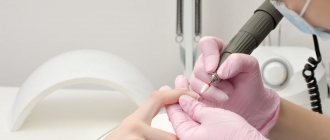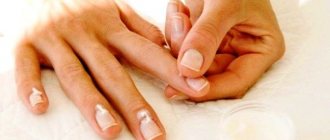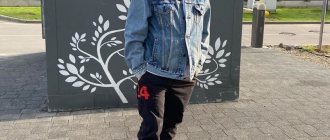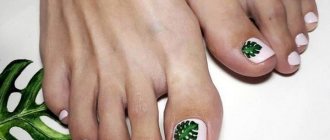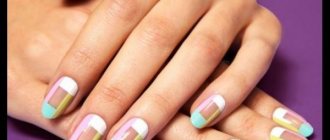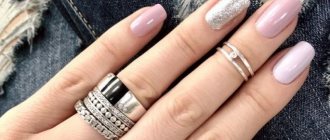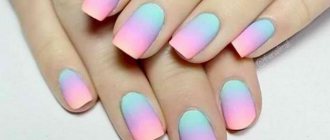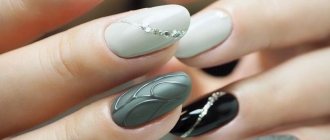About coronavirus
Just because you can get a manicure and pedicure now doesn't mean the pandemic is coming to an end. Quite the contrary: the second wave of “covid” has begun in Europe, one can only guess what it will be like in Russia. However, everyone was tired of both quarantine and the economic crisis: it was vital for beauty salon employees to go to work, many of us really wanted to go to our favorite hairdresser and get ourselves in order. The result: visiting salons has become like a military operation. You can get inside only by appointment at a strictly designated time, everyone’s temperature is measured at the entrance, both the client and the master are wearing masks, equipment and premises are subjected to double processing... Yes, this does not happen everywhere. But it has to be this way to reduce the risk of infection.
In Europe and America, security is monitored much more carefully. Salons even provide gloves with cut off fingers to protect most of the hand from contact with the surface (they are shown in the photo). Try to follow these instructions and demand the same from the salon. After all, only you are responsible for your health.
Avoid your usual cup of coffee or tea in the salon - it’s not a fact that the dishes have been disinfected. The COVID-19 virus lives on surfaces for more than 3 days.
What is it like, a proper “post-quarantine” salon?
Ideally, you should be alone in the salon or in a separate room. If there is no such thing in the salon, a distance of at least 1.5 meters from other visitors must be maintained: you must sit across one table from another visitor. And, of course, remain wearing a mask throughout the entire procedure, just like your master. Yes, it's inconvenient, but it's safe. And if the salon technicians themselves ignore basic safety measures, get up and leave.
The master is required to change gloves and mask after each client - keep an eye on this.
What should a master do?
He must change his gloves to new ones before accepting you. Treat your hands with antiseptic and put on a new mask. Any mask remains safe for two hours, that is, after one session it is no longer suitable. Remember that the virus on various surfaces is active for up to three days - before you sit at the table, the master must wipe the table, chair and everything you can touch with an antiseptic. If he doesn't do this, ask. And, of course, all the instruments he will use must be sterile. Before you sign up for a manicure, find out how and what they process files and scissors in the salon.
Main secret
To make your manicure look neat and tidy for as long as possible, you should choose a nude or transparent finish as a base. Against such a background, you can create any laconic design, because the desire for minimalism is an unconditional trend for the 2020 season. The most interesting thing is that such nail art options are also suitable for short nails and are a stylish decoration for them.
Another condition for maximum manicure durability is a high-quality finishing top. At home, you can use ordinary transparent varnish for this purpose. It’s great if you have a protective base in your arsenal that protects your manicure from damage and chips. Another feature of this final stage is the preservation of the brightness and color saturation of the design.
To refresh the created design, it is recommended to cover it with a top coat once a week - this step will increase the wear life of the manicure.
Interesting: Feng Shui manicure to attract health
What else can you get infected with?
The most dangerous thing is hepatitis. This virus does not die when it dries out and at an air temperature of about +25°, and is transmitted through both fresh and dried blood. That is, if the master does not use dry heat when processing tools, the likelihood of infection is enormous.
The other two most popular diseases are fungus and warts. The first “lives” on untreated nail files, the second on nail baths.
Try not to go to pedicures where baths are built into the chairs - they are very difficult to rinse thoroughly, and therefore bacteria may remain. Dry hardware pedicure is the safest; any wet treatment is an excellent breeding ground for mycobacterium fortuitum.
Hepatitis does not die in the air and can remain on instruments for about four days.
Types of tool processing
Many salons work with disposable files and buffs, but replacing all tools with disposable ones is unprofitable. For example, attachments for hardware manicure and pedicure are very expensive.
All stages of processing manicure instruments are indicated in the requirements of SanPiN, and masters must undergo sanitary inspection at least twice a year and receive a mark in the sanitary book - do not hesitate to ask for it before the procedure, it is done for you and your safety. You have the right to do so! Also, do not forget to clarify how and with what tools are sterilized in the salon. There are several of these types, study the intricacies to understand where it is safest.
The sanitary books of the masters are your safety and you have every right to look at them. Don't hesitate to demand.
Hot air treatment
It is also called “sukhozhar”. Devices and instruments are placed in a special oven and heated to 180 degrees Celsius - at this temperature pathogenic flora and all dangerous bacteria die. This is the safest method today. The disadvantage of this treatment is that sterilization takes at least an hour or two, which is not beneficial for small salons near the metro or islets in shopping centers that operate on a regular basis. In a word, the latter do not use it and it is dangerous for your health.
Unscrupulous craftsmen can get tools in craft bags in front of you and even open it in front of you, but this is not a guarantee of safety. How can you tell if your instruments have actually been exposed to dry heat? The sealed kraft bag should be brown in color and have a sterility indicator inside it that changes from blue to yellow after sufficient processing. If there is no indicator or it is blue, you are being deceived.
Glasperlene sterilizers
The fastest method of sterilization takes no more than a minute. This is a small glass filled with glassy balls that are heated to a temperature of 230 degrees Celsius. You've definitely seen these containers with white crystals on the masters' tables. The disadvantage of the treatment is that here you can only sterilize solid metal objects, for example, a file, but scissors and wire cutters will no longer work; disinfection of areas with creases and complex parts is impossible. In Russia, treatment with glasperlen is prohibited by Rospotrebnadzor; if you see that a master is using them, should you linger at his table?
Unscrupulous craftsmen place tools in a craft bag without processing and deceive clients.
Ultraviolet sterilization
In some salons, tools are placed in devices that resemble toasters - this is a UV cabinet. The principle of operation is simple: the master places pre-cleaned instruments into the device and they are treated with ultraviolet rays, which should kill bacteria. But customers do not even suspect that the UV cabinet is intended only for processing pre-disinfected, sterilized instruments. This is just maintenance of sterilization, not sterilization.
Ultraviolet treatment is not sterilization, it is just additional protection. It is not safe!
Chemical treatment
And the simplest thing is disinfectants. Masters use alcohol-based sprays and aerosols for sterilization. Yes, formulations with bactericidal and fungicidal components destroy most pathogenic microflora. But can you be sure? that the master processed every millimeter of the instrument? No. The human factor has not been canceled. Chemical treatment is carried out immediately after the procedure only to prepare for further sterilization, for example, in the same dry heat.
Avoid beauty salons that use in-chair foot baths.
Occupational safety instructions for a manicurist
Downloads: 167, size: 31.5 KB, date: 05 Dec. 2019
This instruction has been developed taking into account the requirements of legislative and other regulatory legal acts containing state labor protection requirements and is intended for manicurists.
General labor protection requirements
1.1. Persons who have professional training appropriate to the nature of the work, who have undergone a preliminary and periodic medical examination and who have no contraindications for admission to work, as well as training in safe methods and techniques for performing work, labor safety instruction, and on-the-job training are allowed to work independently as a manicurist. and testing knowledge of labor protection requirements.
1.2. The manicurist must comply with the organization's internal labor regulations, work schedule, work and rest schedule.
1.3. A manicurist may be exposed to the following hazardous and harmful production factors during work:
— increased air mobility;
— increased voltage in the electrical circuit;
— insufficient illumination of the workplace;
- overvoltage of the visual analyzer;
— sharp edges of the cutting tool;
- tension in the hands and fingers;
— long-term static physical overload (forced working position “sitting”);
— volatile harmful substances in the air of the working area (acetone, varnish);
— chemical factors (chlorine, ozone, synthetic detergents);
— the danger of contracting parenteral hepatitis and HIV infection when working with sick clients.
1.4. In accordance with current legislation, the manicurist is provided with special clothing and other personal protective equipment provided for by standard industry standards.
1.5. The manicurist must notify his immediate supervisor about any situation that threatens the life and health of people, about every accident that occurs at work, about a deterioration in his health, including the manifestation of signs of an acute disease.
1.6. The manicurist should:
- leave outerwear, shoes, hats, personal items in the dressing room;
— before starting work, put on clean overalls;
- before and after completing customer service, after visiting the toilet, any contamination of hands and before eating, wash hands with soap and wipe dry with a clean towel for personal use;
- care for the skin of your hands using protective and softening agents (cream). Trim nails in a timely manner, clean subungual spaces;
- do not allow eating in the workplace.
Labor protection requirements before starting work
2.1. Do not pin special clothing with pins or needles, do not keep sharp, fragile and breakable objects (scissors, nail files, wire cutters, glass rods, bottles, etc.) in clothing pockets.
2.2. Check by external inspection:
— serviceability of electrical plugs, sockets, power cords of used electrical appliances, a table lamp (no exposed areas, kinks or twisting of power supply wires), make sure that the power tool is in good condition and that the voltage of the network and the electrical appliance corresponds;
— presence and reliability of grounding connections of electrical appliances (no breakage, strength of contact between metal non-current-carrying parts of the device and the grounding wire), do not start work if grounding is absent or unreliable;
- sufficient illumination of the workplace; if necessary, require the replacement of burnt-out lamps or the installation of a lamp that provides greater illumination, direct the table lamp so that the light falls on the client’s hands;
— serviceability and stability of the work table and chair (chair).
2.3. Prepare a towel for personal use.
2.4. Check the availability of the necessary disinfectants and dressings in the first aid kit.
2.5. Make sure that the caps on the bottles are tight and that containers with solutions of disinfectants and other liquids and creams are labeled (name, concentration, date of preparation). All liquids, ointments, creams used during work must have legible markings corresponding to the contents of the bottles (containers).
2.6. Do not work with open wounds on your hands. Protect all damage to the skin on your hands with finger caps and adhesive tape.
2.7. Do not wear bracelets, watches, or rings while working.
2.8. Report any detected malfunctions of the power tools, electrical wiring, lighting and other problems found to your immediate supervisor and begin work only after they have been eliminated.
Labor protection requirements during work
3.1. Perform only the work for which you have been trained, for which you have received instructions on labor protection and approved by the employee responsible for the safe performance of work.
3.2. Operate closed-type bactericidal ultraviolet irradiators (recirculators) with ozone-free bactericidal lamps to disinfect indoor air in accordance with the instructions for their use and only after completing special training.
3.3. Do not entrust your work to untrained or unauthorized persons.
3.4. Use proper tools and devices necessary for safe work; use them only for the work for which they are intended.
3.5. Follow the rules of movement in the room, use only designated passages.
3.6. Keep the workplace clean, promptly remove used napkins, tampons, cut nails, spilled working solutions, and water.
3.7. Open hot and cold water taps slowly, without jerking or much effort. Do not use hammers, other impact instruments or random objects for these purposes.
3.8. Do not block the passages to other workstations, between chairs, to lighting panels, escape routes and other passages with movable tables and unnecessary furniture. Do not accumulate dirty linen in the workplace; transfer it to the utility room in a timely manner.
3.9. Do not use chair armrests, mobile tables, fragile furniture, or random objects for sitting.
3.10. Turn electrical appliances and table lamps on and off with dry hands. When unplugging the electrical plug from the socket, hold onto the body of the plug and do not pull on the supply wire.
3.11. Do not disassemble or attempt to repair electrical appliances yourself.
3.12. Do not wrap the rings of scissors, the handles of nippers, tweezers and other tools with cloth, insulating tape, or other materials to avoid skin flakes and nails getting stuck in them.
3.13. Do not catch falling scissors in flight. Do not walk around the hall with scissors open.
3.14. Do not dry wet laundry (napkins, towels) on heating radiators, electric water heaters, or other equipment. Wet laundry should be dried in a utility room or electric drying cabinet.
3.15. Keep nail polish removers and varnishes in tightly closed containers away from fire, in a cool place.
3.16. Clean the table surface from trimmed nails and skin scraps after each visitor.
Wipe all items on the table several times a day with a cotton swab soaked in alcohol or a 0.5% chloramine solution.
3.17. Before starting to serve the visitor, carefully examine the condition of the nails and skin of the hands; If there are pronounced changes in the appearance of nails and skin, indicating contagious diseases, do not serve the client.
3.18. When performing a manicure, use a disposable napkin for each visitor. Store sterile manicure instruments in metal trays. To store tools prepared for work at the workplace, it is allowed to use bactericidal ultraviolet irradiators.
3.19. Instruments used for manipulations that may cause damage to the skin during manicure must be disinfected, pre-sterilized and sterilized after each client.
To prevent the spread of parenteral hepatitis, HIV infections, tuberculosis, other infections and parasitic diseases, disinfection of working tools must be carried out according to regimes effective against the causative agents of these infections.
3.20. The sterilization method should be selected depending on the purpose and characteristics of the instruments being processed.
Sterilization must be carried out in accordance with the guidelines for disinfection, pre-sterilization cleaning and sterilization of medical devices.
3.21. When disinfecting instruments in ethyl alcohol, it is necessary to ensure that the alcohol is clean and strong, and that the cutting surface of the instrument is completely immersed in alcohol.
After finishing the work, filter the alcohol through gauze to remove any flakes of skin and nails that have gotten there.
3.22. In order to prevent infection with parenteral hepatitis and HIV infection, all manipulations during which hands may become contaminated with blood must be carried out using rubber gloves.
3.23. If blood gets on your skin, wash it thoroughly with soap; If the skin is damaged (cut, injection), squeeze out the blood from the wound, treat the surface with 70% alcohol, then with a 5% iodine solution.
3.24. When working with disinfectants, you should use only moderate and low-hazard disinfectants (hazard classes 3 and 4), non-volatile and non-dusting, in hygienic and ready-to-use formulations.
3.25. It is necessary to use hand protection when preparing disinfectant solutions and disinfecting instruments.
3.26. When working with disinfectants you should:
— the preparation of disinfectant solutions should be carried out in special rooms with artificial or natural supply and exhaust ventilation;
— pour dry disinfectants into special containers with gradual addition of water;
— containers with working disinfectant solutions must be tightly closed with lids;
— perform all work with solutions wearing rubber gloves;
— observe precautions and use personal protective equipment (respirators, masks, etc.) specified in the instructions for the disinfectant used;
— use the original disinfectants in small packaging as much as possible.
3.27. Do not prepare or use homemade cosmetics yourself.
Occupational safety requirements in emergency situations
4.1. If during work the workplace becomes contaminated with spilled solutions, stop work until the contaminants are removed.
4.2. In the event of a power failure, a break in a pipeline or a heating radiator, it is necessary to stop work and call the appropriate emergency team by telephone.
4.3. In an emergency situation, notify employees and visitors of the danger, report to the immediate supervisor about the incident and act in accordance with the emergency response plan.
4.4. If a fire or signs of combustion are detected (smoke, burning smell, increased temperature, etc.), you should:
stop work and immediately report the fire by calling 101 or 112 to the fire department, giving the address of the facility, the location of the fire, and giving your last name;
if possible, take measures to evacuate people, extinguish fires and ensure the safety of material assets.
4.5. In case of injury or sudden illness, a victim must be given first aid and, if necessary, arrange for his delivery to a healthcare facility.
Labor protection requirements upon completion of work
5.1. Turn off the work lights, turn off the power tools you are using and disconnect them from the power supply (unplug the plug from the socket).
5.2. Disconnect the cosmetology device from the network, remove the micromotor tip from the holder, after first removing the nozzle.
5.3. In accordance with methodological instructions, clean, disinfect and sterilize sets of working instruments.
5.4. Clean and disinfect your desk. Place all manicure accessories, disinfectant solutions, alcohol, varnishes, nail polish removers, etc. in specially designated storage areas. Close the caps of all bottles tightly.
5.5. It is not allowed to sweep cut nails or skin scraps off the table with your hand. Cleaning should be done using a sweeping brush and dustpan.
Share link:
Why are you being lied to?
Masters who can harm you are divided into two types: the first ones do not know that they are harming you, the second ones want to save money. A common case: a master worked in a salon where there was a small dry heater, which was installed by the management of the salon; he believes that this device is safe. Afterwards, the same master begins to work for himself and buys already familiar equipment. He simply does not know that such a tendon does not have a registration certificate and is useless! Only a dry heater with a registration certificate can sterilize.
About those who want to save money. Often the owners of small salons are not manicurists and know little about infections and the dangers of manicure. So, for a manicure island where 10 masters work, a mini-dryer is purchased, in which there is little space and the sterilization tools are stacked on top of each other. The main rule of dry heat is that hot air must circulate! If the instrument is lying on the instrument, it will not become sterile even after 5 hours of treatment.
After proper sterilization, the indicator in the craft bag changes from blue to yellow.
Halves
“Half” manicure quickly gained popularity due to the fact that it is a stylish and practical solution. Its essence lies in the design of only one half of the nail. This can be a plain coating with a thin border of stripes, rhinestones, various patterns and creative color combinations. Any option will look relevant and will not give away its actual “expiration date”. You can find inspiring examples in the photo below.
How to protect yourself?
Try to go to nail salons that have been in business for many years. Firstly, they value their reputation, and secondly, SanPin has not closed them yet - this is also an indicator.
Pay attention to whether the master throws away the tools after you - if not, then most likely, you also had a manicure done with a nail file from a previous client.
Before a manicure, demand that the craft bag be opened in front of you and be sure to ask to see the notorious indicator. Do not be shy! If the master has everything in order with safety precautions, he will even be pleased to show his professionalism and care for clients.
Another tip is to avoid shaving your legs the day before your pedicure. It sounds strange, but the razor leaves microcuts on the legs, through which bacteria enter the bloodstream - the cause of furunculosis.
You can come to the salon with your own tools - this is the safest thing. Pick them up with your master and always carry them with you. But before each procedure, the master must sterilize them.
Lunar design
There is another classic of the genre that guarantees a design that will last. We are talking about a lunar manicure with its characteristic transparent hole. In the traditional design, such an element is made in the shape of an arc, and the rest of the nail is covered with flesh-colored varnish. But today the color boundaries for lunar design are virtually limitless, and the moon itself willingly changes its shape and accepts various decor for company.
You can also diversify the usual lunar design with the help of sparkles or a mesmerizing “cat’s eye” effect.
